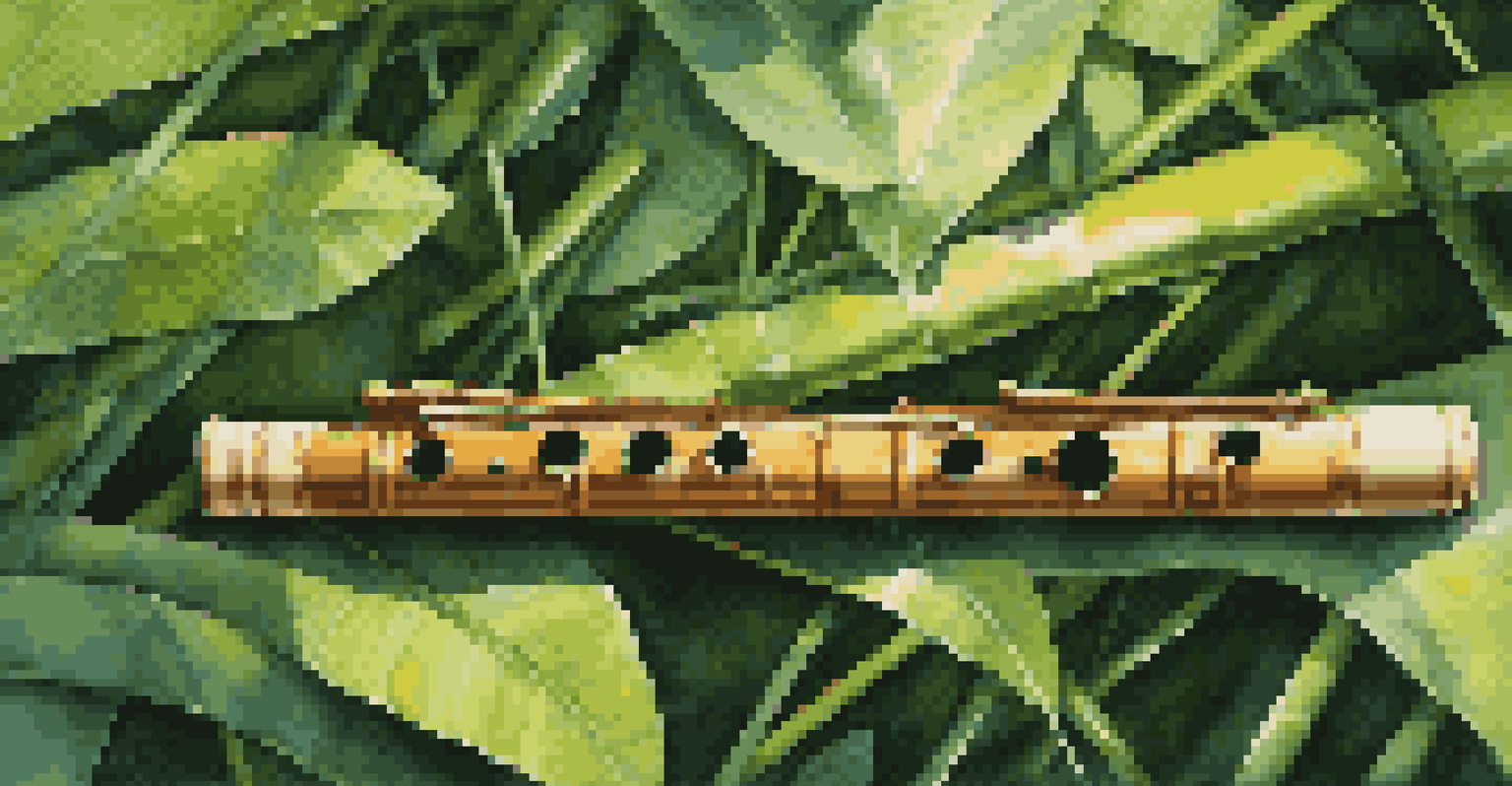Environmental Soundscapes: Music Inspired by Nature

What Are Environmental Soundscapes?
Environmental soundscapes refer to the auditory environments that surround us, including natural sounds like birds chirping, water flowing, and wind rustling through trees. These sounds create a rich tapestry of audio experiences that can evoke various emotions and memories. Just as visuals shape our perception of nature, soundscapes play a crucial role in how we experience the world around us.
The earth has music for those who listen.
Imagine walking through a forest, where every rustle of leaves and distant bird call contributes to an immersive experience. This auditory environment not only enhances our connection to nature but also influences our mental state. Studies have shown that exposure to natural soundscapes can reduce stress and promote relaxation, proving that what we hear is just as important as what we see.
In recent years, environmental soundscapes have gained attention in the music world, inspiring artists to incorporate these natural sounds into their compositions. By capturing and blending these elements, musicians create pieces that resonate with the beauty and tranquility of nature.
The Role of Nature in Music Creation
Nature has served as a muse for countless musicians throughout history, inspiring everything from classical symphonies to contemporary electronic tracks. Composers often draw upon the rhythms and patterns found in the natural world, translating them into melodies and harmonies. This connection between music and nature creates a profound listening experience that transports us to different environments and evokes specific feelings.

For instance, consider Claude Debussy’s 'La Mer,' which paints a vivid picture of the sea through its fluid melodies and dynamic rhythms. Similarly, modern artists like Sigur Rós weave ambient sounds from their surroundings into their music, creating a soundscape that feels both organic and otherworldly. These examples highlight how nature can shape and inspire musical expression across genres.
Nature's Sounds Enhance Music
Musicians draw inspiration from environmental soundscapes, using natural sounds to create immersive and emotional compositions.
Moreover, the integration of natural sounds in music not only enhances the auditory experience but also encourages listeners to appreciate the beauty of the environment. As we listen, we are reminded of our connection to the Earth and the importance of preserving these soundscapes for future generations.
Instruments Inspired by Nature
Many musical instruments draw inspiration from natural elements, both in their design and the sounds they produce. For example, the didgeridoo, an ancient wind instrument from Australia, mimics the sounds of the natural world, such as animal calls and wind. Similarly, the ocean drum creates a soothing wave-like sound, reminiscent of the sea, adding an ethereal quality to musical compositions.
Nature is not a place to visit. It is home.
Instruments like the kalimba, with its plucked tines, evoke the sounds of raindrops falling on leaves, while the bamboo flute captures the essence of wind flowing through trees. These instruments not only reflect the beauty of nature but also invite musicians to experiment with sounds that resonate with the environment. By incorporating these instruments, artists can create music that feels alive and connected to the Earth.
As musicians increasingly seek to connect with their surroundings, the use of nature-inspired instruments has become more prevalent. This trend not only enriches musical compositions but also fosters a deeper appreciation for the intricate relationship between sound and the natural world.
Field Recordings: Capturing Nature's Sounds
Field recordings involve capturing sounds from natural environments, such as forests, rivers, and urban parks, to preserve the unique audio experiences of these spaces. This practice has gained popularity among musicians and sound artists, who use these recordings to create immersive soundscapes that transport listeners to specific locations. By blending field recordings with music, artists can evoke the feeling of being present in nature.
For instance, the work of sound artist Chris Watson often features recordings of wildlife and landscapes, creating an auditory experience that invites listeners to engage with the environment. These recordings serve as both a documentation of natural sounds and a source of inspiration for new musical compositions. The result is a unique blend of nature and art that highlights the beauty of our surroundings.
Field Recordings Capture Nature
Field recordings preserve the unique auditory experiences of natural environments, inviting listeners to reconnect with nature.
Additionally, field recordings remind us of the importance of preserving natural spaces. As we listen to these sounds, we become more aware of our environment and the need to protect it from urbanization and climate change. This awareness is essential for fostering a greater appreciation of the world around us.
The Healing Power of Nature Sounds
Many people turn to the sounds of nature for relaxation and healing, utilizing them in practices such as meditation, yoga, and mindfulness. The soothing sounds of rain, ocean waves, or rustling leaves can create a calming atmosphere, helping to reduce anxiety and promote mental clarity. Research has shown that listening to nature sounds can lower stress levels and improve overall well-being.
For instance, sound therapy sessions often incorporate recordings of natural environments to create a serene space for relaxation. Similarly, many wellness apps feature playlists of nature sounds designed to help users unwind and recharge. This trend reflects a growing recognition of the therapeutic benefits that environmental soundscapes provide.
By integrating nature sounds into our daily routines, we can cultivate a sense of peace and connection to the world around us. This practice not only enhances our well-being but also encourages us to be more mindful of the natural environments that inspire these calming sounds.
Environmental Soundscapes in Film and Media
Environmental soundscapes play a crucial role in film and media, enhancing storytelling by creating immersive experiences for audiences. From the rustling of leaves in a forest to the distant sound of thunder, these audio elements help set the mood and transport viewers into the narrative. Filmmakers often use sound design to evoke emotions, making nature an essential part of the cinematic experience.
For example, in films like 'Into the Wild,' the sounds of nature are integral to the storytelling, immersing the audience in the protagonist's journey. Similarly, documentaries that explore wildlife or natural habitats rely heavily on environmental soundscapes to convey the beauty and complexity of the natural world. These sound elements remind us of our connection to nature and the importance of preserving it.
Healing Benefits of Nature Sounds
Listening to nature sounds promotes relaxation and mental clarity, highlighting their therapeutic benefits in daily practices.
With the rise of streaming platforms, soundscapes have become more accessible than ever. Viewers can now experience the soothing sounds of nature in documentaries, travel shows, and even guided meditation programs. This trend highlights the growing recognition of the power of sound in shaping our understanding of the environment.
The Future of Music and Environmental Soundscapes
As awareness of environmental issues continues to grow, musicians and sound artists are increasingly using their platforms to advocate for nature preservation. By incorporating environmental soundscapes into their work, they raise awareness about the importance of protecting natural habitats and the sounds they contain. This trend not only enriches their music but also serves as a call to action for listeners to engage with environmental issues.
Moreover, advancements in technology are making it easier for artists to capture and manipulate natural sounds. With tools like portable recording devices and sound editing software, musicians can create innovative compositions that blend traditional music with environmental soundscapes. This fusion of technology and nature allows for new musical expressions that resonate with audiences.

Ultimately, the future of music and environmental soundscapes lies in our ability to foster a deeper connection with nature. By continuing to explore this relationship, we can create a more sustainable world that honors the beauty and diversity of the environment while inspiring future generations of musicians and listeners alike.